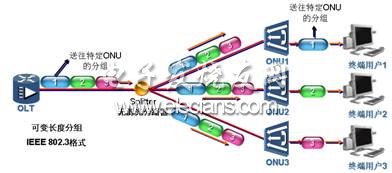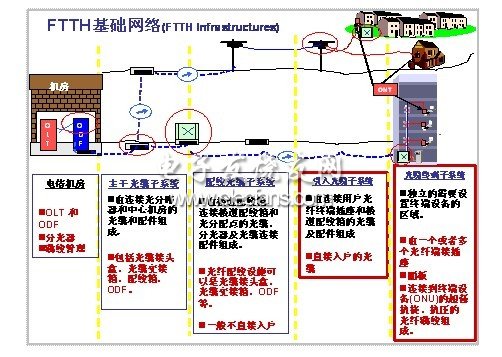1 Summary
PON technology has become a hotspot of global broadband operators, and is considered to be one of the best technical solutions to achieve FTTH. It consists of OLT (OpTIcalLineTerminal, optical network terminal), ODN (OpTIcalDistribuTIon Network, optical distribution network) and ONU (OpTIcal Network Unit, optical network unit). For the commercial scale deployment of FTTH, regardless of whether EPON or GPON is used, operators need to understand what is happening on the line connecting the network elements in the network topology, especially in the ODN part. ODN accounts for more than half of the initial investment in the FTTH project. The quality of its planning and construction will have a great impact on the future network scale operation and maintenance costs. ODN is currently a part of particular concern for operators, especially in the customer premises network, that is, within the last 100 m of fiber access.
3M is one of the earliest advocates and implementers of FTTH. It has global leading products and rich experience in optical fiber lines and connection. Since there is no perfect PON-based FTTH line engineering design specification so far, on the basis of summing up the experience and lessons of the domestic FTTH pilot, and combining the actual experience in other countries, 3M has proposed a domestic PON-based FTTH line solution The plan and the basic design principles that should be followed.
2 Structure of ODN
FTTH line construction must face various building types: residential areas, including low, medium, and high-rise residential buildings; commercial buildings, including various office and commercial buildings; villas and other independent houses; and industrial parks, including various buildings.
Regardless of the building type, the PON-based FTTH network from the access network room where the OLT is located to the user where the ONU is located can be divided into the following five parts, in order from the user end to the access network room: optical cable terminal sub The system, the introduction of optical cable subsystem, the distribution optical cable subsystem, the backbone (feeder) optical cable subsystem and the central machine house system, as shown in Figure 2.

(A) Upstream

(B) Down
Figure 1 PON network topology

Figure 2 Division of PON line structure
33M's ODN design plan
3.1 Core concepts in ODN design
Through the understanding of the domestic fixed network operator's network and deployment capabilities, 3M Company determined that in the basic network construction, the operator is most concerned about the optical cable terminal subsystem, the introduction of the optical cable subsystem and the distribution optical cable subsystem in the ODN structure. Due to the large number of domestic FTTB and FTTC deployments, operators have accumulated rich experience in the construction of backbone optical cable subsystems and machine house systems.
Aiming at the concerns of domestic operators, 3M Company combines the basic network structure and other factors with 3M's core technologies and products to launch the following four core concepts in the FTTH line deployment.
(1) The concept of optical fiber termination
No matter where the optical fiber stops, the optical fiber must be terminated and protected in the socket (like the termination of the copper data cable of the telephone box and the coaxial cable of the cable TV).
(2) Optical fiber field termination
In the customer premises network (in the building) and the user room, the optical fiber plugs and sockets should be made on site to replace the traditional factory-made fixed-length pigtails / jumpers.
(3) Application of optical fiber mechanical splicing technology
In the customer premises network (in the building) and the user room, when the optical fiber connection is performed, mechanical connection should be used instead of fusion splicing. In order to solve the shortcomings of high tool investment, high maintenance cost, long time consumption and inflexibility caused by the use of traditional fusion splicing for the small core number and scattered multi-site fiber connection.
(4) Adopt special fiber optic cable
Use FTTH dedicated fiber optic cable to replace the traditional pigtail, jumper or armored tail, to ensure the flexibility, safety and reliability of indoor and indoor wiring.
The purpose of the above four concepts is to make the design, construction, maintenance and service opening of optical fiber lines as convenient and reliable as copper cable systems.
The positive active material is mainly made of nickel, and the negative active material is mainly an alkaline battery made of cadmium.The nickel-cadmium battery used in AGV car has large internal resistance and can be used for large current discharge.Compared with other kinds of batteries, nickel-cadmium batteries can withstand overcharge or overcharge, and the operation is simple and convenient.The discharge voltage is somewhat different according to the discharge current. In general, the discharge termination voltage of about 1.2v nickel-cadmium battery is 1.0v /CELL, and the actual operating temperature ranges from -20 degrees to 60 degrees. In this range, the discharge can be repeated for more than 500 times.
Nickel Cadmium Battery,Nickel Metal Hydride Battery,Nickel Cadmium Rechargeable Battery,Nickel Cadmium Storage Battery
Xinxiang Taihang Jiaxin Electric Tech Co., Ltd , https://www.chargers.be
